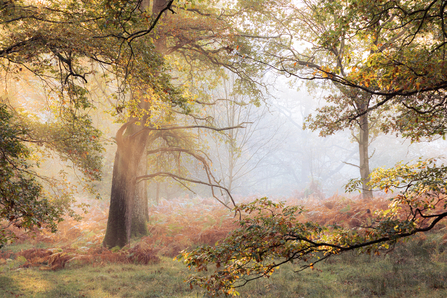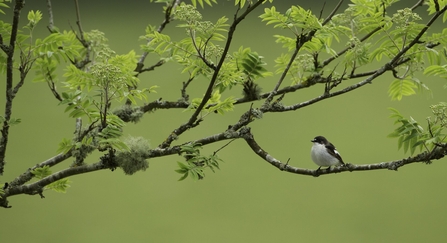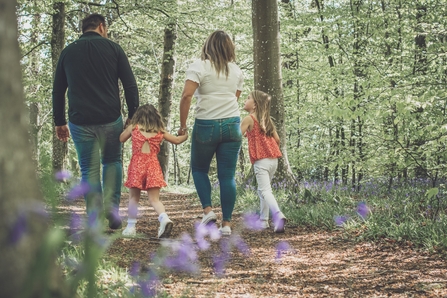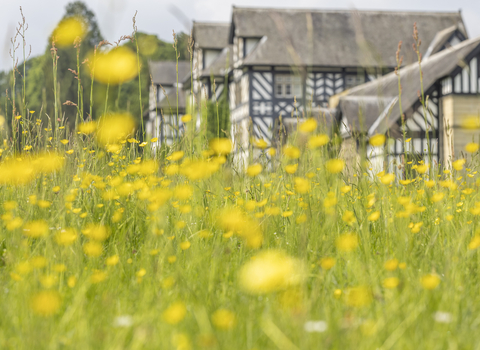Thanks to an exciting new partnership, we’ll be working with Gregynog on their Welcome Home to Nature project to enhance the historic Montgomeryshire estate for wildlife and people.
Gregynog’s 750-acre grounds in Tregynon near Newtown are already a nationally-important haven for wildlife. The majority of the estate lies within a National Nature Reserve (NNR) – one of Wales’ most important areas of ancient parkland and wood pasture. Meanwhile its ancient oak-filled Great Wood is a Site of Special Scientific Interest (SSSI) teeming with wildlife, much of it rare, including lichens, birds like Pied Flycatchers and Wood Warblers and several species of bats. Miles of waymarked paths snaking through the woodland, wildflower meadows and a large Lily Pond ablaze with multi-coloured dragonflies, meanwhile, are just some of the existing opportunities for visitors to enjoy and connect with this wealth of wildlife.
“We’ll be improving existing wildlife habitats, boosting biodiversity and enhancing the nature-themed visitor experience – to make this a place where wildlife thrives and where people can connect with, and learn about, nature…”
Welcome Home to Nature is funded by the Nature Networks Programme, which is a Welsh Government fund developed in partnership with Natural Resources Wales administered by the National Heritage Lottery Fund (NHLF) on behalf of Welsh Government.
This two-year project will see our two organisations working together to build on these strong foundations, improving existing wildlife habitats, boosting biodiversity and enhancing the nature-themed visitor experience – to make this a place where wildlife thrives and where people can connect with, and learn about, nature.

Gregynog boasts wildlife-rich ancient woodland Photo: © Brad Carr
To make this happen, first we’ll be mapping and monitoring the estate’s habitats, and species, complimenting the work done on specific areas of the estate by Natural Resources Wales (NRW) - to discover more about the plants and animals that call Gregynog home. As part of this we’ll be surveying breeding birds and bats, fungi and dormice. This data will form the basis for engaging interpretation to help visitors understand what a special place for wildlife Gregynog is, and why its grounds need to be managed with this in mind.

Pied flycatcher by Mark Hamblin/2020VISION
Boosts to biodiversity
Restoration work across the estate will be designed to increase biodiversity, including restoring the Lily Pond and wildflower planting along the drives, plus supporting the ongoing walled garden restoration. Additionally, installing nest boxes specially designed for Pied Flycatcher and other summer migratory birds will help support rare avian populations, and planting of more wildflowers and flowing trees will promote insect-life, the foundation of a healthy ecosystem.
“Gregynog is an amazing site with a huge variety of different habitats, including some which are nationally important. We have some historical records for rare wildlife such as Lesser Horseshoe Bat and Hazel Dormouse, but this project will allow us to map the site to understand how valuable it is to nature. At the same time the events will encourage people to come along to Gregynog and learn about the wildlife for themselves.”Montgomeryshire Wildlife Trust
Family-friendly forays
Meanwhile, Gregynog’s offering will be made even better for visitors, with a new woodland play and picnic area, more opportunities for walking, cycling and running by creating new paths – such as adding a path up the Warren, where there are spectacular views – and improving existing ones to make them more accessible.
We’ll also be putting on 13 nature-themed events at Gregynog - including bat walks, fungi forays, den-building and pond-dipping – that will be perfect for engaging families with nature and inspire young people to protect their natural environment.

We’ll be putting on 13 nature-themed events at Gregynog that will be perfect for engaging families with nature Photo: © Puddleduck Photography
People power
Keeping people firmly at the heart of this project, we’ll be setting up a dedicated volunteer group to assist with practical habitat management and species surveys on the estate. We’ll also be supporting Gregynog’s staff and volunteers to develop their skills to continue this monitoring and managing into the future – just one of many project legacies.





